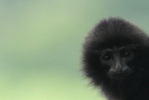Discovering a species unknown to science is a highlight of any biologist’s career, but imagine discovering a new ape? Researchers with the German Primate Center (DPZ) announced today the discovery of a new species of ape in the gibbon family, dubbed the northern buffed-cheeked gibbon (Nomascus annamensis), according to the AFP. The new species was discovered in rainforests between the borders of Vietnam, Laos, and Cambodia: an area that contains a number of gibbon species.
The new species had been thought by past researchers to be the yellow-cheeked gibbons (Nomascus gabriellae), however analysis of the animals’ DNA and distinct calls convinced researchers that although the species looks almost exactly like yellow-cheeked gibbons, they were in fact a wholly different gibbon.
Both of the gibbons belong to the family of ‘crested gibbons’, one of the most imperiled groups of mammals in the world. Yellow-cheeked gibbons are currently classified as Endangered by the IUCN Red List due to habitat loss, hunting, and the pet trade. Other crested gibbon species are down to less than 200 individuals.
“The crested gibbons are the most threatened group of primates and all species require urgent attention to save them from extinction”, Thomas Geissmann, gibbon expert from Zurich University and adviser with Fauna & Flora International (FFI), recently said.
It’s likely this new species—the northern buffed-cheeked gibbon—is also facing extinction, yet more research needs to be conducted. Many of the crested gibbons have been under-researched to date and scientists are still uncertain of some species’ range and population making conservation efforts difficult. Gibbons have long been overlooked by researchers and conservationists compared to their more popular ape relatives.
Scientists have dubbed gibbons the ‘lesser apes’ since they share some behavioral and physical characteristics with monkeys, but, like all apes—gorillas, chimpanzees, orangutans, and humans—they possess no tail. Gibbons are known for their high-flying rapid-swinging antics among their lives in trees and their booming unmistakable songs. They are the world’s fastest arboreal mammal without the power of flight.
Related articles
Scientists warn little known gibbons face immediate extinction

(09/19/2010) It’s not easy to be a gibbon: although one of the most acrobatic, fast, and marvelously loud of the world’s primates, the gibbon remains largely unknown to the global public and far less studied than the world’s more ‘popular’ apes. This lack of public awareness, scientific knowledge, and, thereby, conservation funding combined with threats from habitat loss to hunting to the pet trade have pushed seven gibbon species, known as ‘crested’, to the edge of extinction according to scientists attending the 23rd Congress of the International Primatological Society.
Humans push half of the world’s primates toward extinction, lemurs in particular trouble
(02/18/2010) Of the known 634 primate species in the world 48 percent are currently threatened with extinction, making mankind’s closes relatives one of the most endangered animal groups in the world. In order to bring awareness to the desperate state of primates, a new report by the International Union for the Conservation of Nature highlights twenty-five primates in the most need of rapid conservation action. Compiled by 85 experts the report, entitled Primates in Peril: The World’s 25 Most Endangered Primates, 2008–2010, includes six primates from Africa, eleven from Asia, three from Central and South America, and five from the island of Madagascar.

(09/24/2009) There are 200 Tonkin snub-nosed monkeys left in the world. The cao vit gibbon, however, is even worse off with only 110 individuals remaining, giving it the dubious honor of being the second most endangered primate in the world (the closely-related Hainan gibbon with only 17 individuals is likely number one). Both of these species—the cao vit gibbon and Tonkin snub nosed monkey—have received good news recently as new reserves in China and Vietnam have been created in part to aid their survival.
